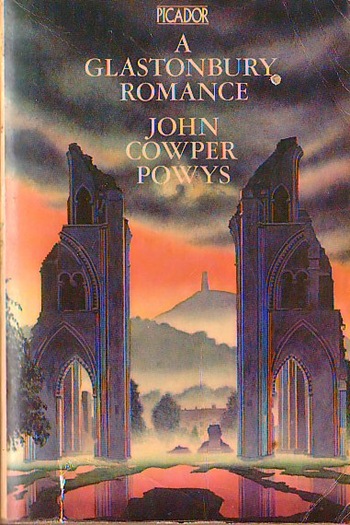I first read this monster (1120 pages) of a novel back in 1975 and was really taken by it then. It has resonated in my memory over the decades, and though I haven’t, until the last week or so, picked it up to read again. I’m glad I did.
It took me about two weeks of leisurely reading (a few hours a day) to reach the end, but each time I put it down, I felt its allure and longed to get back into it.
A Glastonbury Romance is by no means a page turner in the usual sense, being verbose with many digressions from the story line in philosophical meanderings. However, it has enormous presence and a highly charged atmosphere throughout.
John Cowper Powys was an interesting fellow; a novelist, poet, philosopher and critic. He wrote many novels, all rather substantial, and though I have a good collection of his other novels, A Glastonbury Romance is my particular favourite.
The novel is set in the small town of Glastonbury in Somerset and follows events in the lives of its residents over course of a year.
Glastonbury is notable for its association with Arthurian myths involving Joseph of Arimathea and The Holy Grail and A Glastonbury Romance uses this as its main theme.
Powys himself described the novel as being primarily about the Grail:
Its heroine is the Grail. Its hero is the Life poured into the Grail. Its message is that no one Receptacle of Life and no one Fountain of Life poured in the Receptacle can contain or explain what the world offers us
Make of that what you will, but I generally see the novel as a good BIG read. A Glastonbury Romance has a huge cast of characters, the principal protagonist being John Geard a mystic and preacher , who having been bequeathed a large sum of money, uses this windfall to create a new religion based on the Grail. He’s a memorable character with his mystic blood and guts religious fervour; his nickname is “Bloody Johnny” culled from his frequent use of the expletive “Blood of Christ”
Opposed to Geard is Philip Crow, who represents the capitalist, pragmatic side of the political spectrum. He is an industrialist and cares nothing for the myths and legends that dominate Glastonbury and wants to build a new bridge to replace the ancient Bridge Perilous, opens a tin mine in Wookey Hole, and owns several dye manufactories.
But that is only two characters among many. They are all remarkable in one way or another. A Glastonbury Romance is rich in detail, from exquisite glowing descriptions of the landscape to complex characterisations. As I said before, the novel has a highly charged tone and contains many dramatic scenes that are vivid and thrilling. It’s got more than its fair share of sex, politics, religion and mysticism, as well as the odd magic realist moment.
It’s certainly not to everyone’s taste, but if you like big complex novels that explore large themes, then A Glastonbury Romance may appeal.
The following passage from the novel is one that has remained with me since 1975, though I had confused its setting in my head, associating it with a different set of characters and set in a different dwelling. It describes a bowl of bluebells and gives you some idea of the power of Powys’ prose.
In the centre of the kitchen was a bare deal table, the well-scrubbed top of which had assumed, so soft and friendly did it look, the whiteness of a pail of rich cream. On this table was a huge glass bowl filled with an immense, tightly packed mass of bluebells. The gorgeous blueness, a deep Prussian blue mingled with blotches of purplish rose up like a thickly packed cloud of almost opaque essence out of this bowl of heavy-drooping blooms and expanded and expanded till its richness of tint attracted towards it and seemed utterly to absorb all other coloured things in the room. It dominated the gleam of the shining pots and pans of that small kitchen as completely as its fragrance overpowered the smell of the cooking.
If this post has piqued your curiosity, there is an interesting and perceptive article by Margaret Drabble on John Cowper Powys, which appeared in the Guardian in August 2006, and is well worth reading.


2 comments:
This has piqued my interest! And if that excerpt is anything to go by the book sounds like an intense and absorbing read (and chimes very well with your violets above, coincidentally). I shall look out for his work - thanks for drawing me attention to him.
I've managed to find and order that Road to Baghdad one you mentioned, by the way - so thanks very much for that too!
Clare, I hope you enjoy On the Road to Baghdad. I loaned my copy to some friends when they travelled to Turkey and they loved reading it context.
Powys is not for the fainthearted, but he is quite unique.
Post a Comment